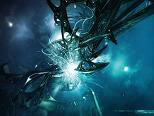Back then, anyway. Luck be a laddie if director Gregory Hoblit’s career hasn’t booked a ride on the Bart Simpson hair-do for the past ten years. Frequency is a spike, a gun-and-badge sci-fi/drama that’s heavy on the drama and light on the sci-fi. Jim Caviezel and Dennis Quaid are the father and son drama duo sporting their “I love yous” and tough-guy tears over an interval of thirty years.
In 1999, Caviezel is John “Chief” Sullivan, the dispassionate New York cop with a chip on his shoulder about the death of his father, Frank (Dennis Quaid), a firefighter and die-hard Mets fan. On the eve of the 30th anniversary of Frank’s death, the discovery of his father’s ham radio prompts John to seek guidance from memories drowned by booze and bygone days. He comes home to be greeted on air by a friendly New York firefighter named Frank. Who is a Mets fan. AND has a six-year-old son named Johnny whom he calls “Chief.”
Think you know where this is going by now, don’t cha?
Yeah, you probably do. In 1969, Dennis Quaid is Frank Sullivan who tunes into his ham radio to find a man named John, who lives at the same address as Frank and knows that this is Frank’s last night on earth. Tomorrow, he will die unless “he goes the other way.”
And he does. In the blink of an eye (literally), John remembers his past as it might have been had his father lived, played ball, had a Mustang. Between a black leather jacket and five o’clock shadow, Caviezel is the agitated, inky anti-hero. He’s the street-smart cop who can catch a killer, but whose relationship is out on the front porch where his girl-friend Sam (played by a weepy but beautiful Melissa Errico) is leaving him. His excuse: it’s not her, it’s him. Sorry dude, but we don’t feel sorry for you.
Until, by saving Frank, John steps on a proverbial butterfly, allowing his mother Julia (Elizabeth Mitchell) to save Jack Shepherd (Shaw Doyle), a two-faced cop with a deadly secret: he’s a serial killer, dubbed the Nightingale, with a fetish for nurses. Meanwhile, in 1999, John makes a daunting discovery. Not only have the Nightingale’s victim’s increased, but staring back at him from the crime scene photos are the bloody images of one Julia Sullivan. Now, father and son must bridge a gap of thirty years to stop a killer before he destroys Frank’s present – and John’s future along with it.
With the investigation taking place between different time periods, the film shifts constantly between past and present. There are no markers, except in the beginning of the film, that signify a change in setting. Yet, the two are like sides of a coin with little or no transition, but doubtless part of the same whole.
Likewise, the chemistry between Caviezel and Quaid is magnetic. The former is the grave and despondent negative, the bad cop who shoots with the good guys, fishing for answers at the bottom of the beer bottle. Quaid, on the other hand, is all positive. He’s the all-American dad from Queens who drops his Rs, rides a motorcycle, and can’t get enough of the great American past-time. Essentially, as the first-rate firefighter playing second-rate cop, he’s a good actor with the wit to play a bad one.
Per contra, Elizabeth Mitchell (found on the big-screen, Lost on ABC) is good all around as the devoted wife and doting mother, winning the hearts of father and son with spoiled bouillabaisse. In the powerhouse of Quaid and Caviezel, Mitchell is no stick-figure in the almost-picture-perfect image of the All-American family.
Neither is Andre Braugher (Men of a Certain Age, The Mist) as Satch DeLeon, the skeptical cop whose arrival at the Sullivan home in one scene is likened to a fiery version of Sidney Poitier’s Vergil Tibbs. Shawn Doyle (Big Love) is underdeveloped as the bad guy, but, with or without the mullet, he looms long enough to darken a couple of doorways, past and present.
In director Gregory Hoblit’s past, Braugher starred in the 1996 box office hit, Primal Fear, starring Richard Gere and Edward Norton (whose performance earned an Oscar nomination for Best Supporting Actor). Strangely enough, Frequency, one of the highest rated films in Hoblit’s career, received so many rejections from Hollywood’s elite that the prospects of the film’s debut seemed bleak. Sylvester Stallone reportedly turned down the role of Frank Sullivan due to a dispute on wages. What jump-started the film’s production, however, was Caviezel’s decision to abandon the role of Cyclops in 2000s X-Men to play John Sullivan.
While sci-fi buffs will find the film’s edge on fantasy bordering on dull, serious viewers will find one or two things to nit-pick about (the same ones who think mail boxes that send love-letters across time are a perfect example of the corny side of love). Nevertheless, the film oscillates well between drama and sci-fi (neither a day at the precinct nor a night with Kang and Kodos), so tuning in is worthwhile if only for the implausibility.

